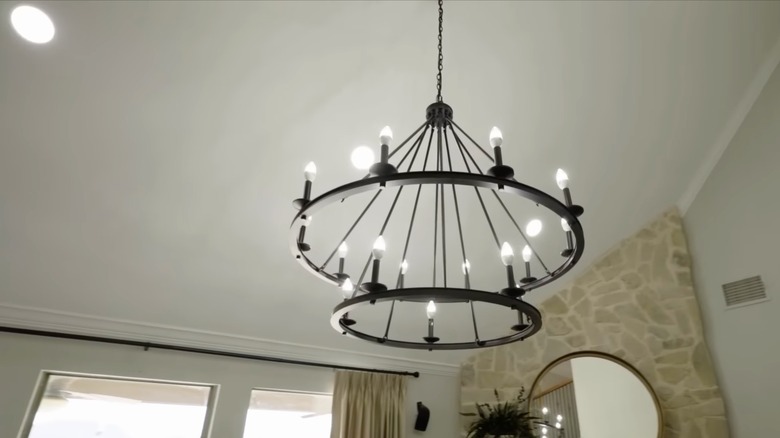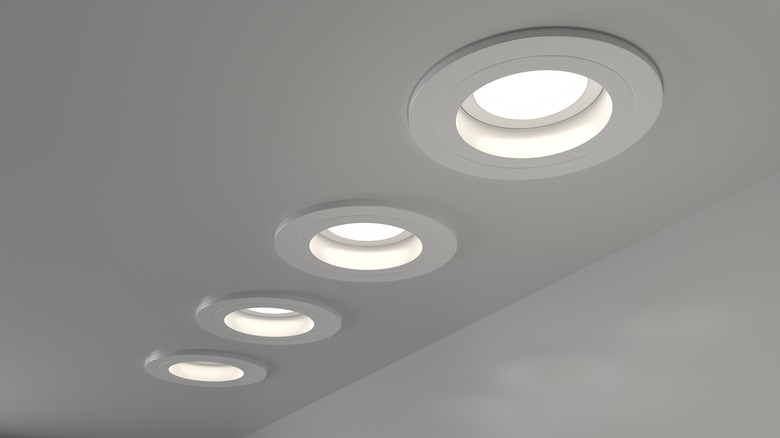The Simple Lighting Design Jenn Todryk Uses For Big Impact On A Dark Room
Good lighting is a must when it comes to interior design. A dark room can feel cave-like and hide the intricate details of a well-designed space. Getting the lighting right in a dark room can be tricky. The right fixtures make all the difference. Jenn Todryk from HGTV's "No Demo Reno" has a simple fix that brightens up a dim room. In one episode, her clients had a ceiling fan in the living room that gave off little light. The room was so dim because it was missing the right kind of lighting. "You have no cans in here," Todryk told them (via YouTube). "Like, no can lighting." Todryk believed adding a few of these fixtures to the ceiling would make a huge difference when it came to the amount of light in the room.
Can lighting is a type of recessed lighting that's installed on the ceiling, and it could be perfect for your home. Can lights focus light downward, allowing the room to be illuminated from above. It is also pretty unobtrusive since the actual bulb is set into the ceiling rather than hanging below. The trim is typically the only visible part on the ceiling itself. This discrete design allows it to blend into the ceiling and makes it perfect for combining with other fixtures that may offer more style but little to brighten the space.
Adding can lights to your home
Jenn Todryk is all about updating a home without having to go through a major renovation. So, when her clients had a dim living room, the answer wasn't adding pricey floor-to-ceiling windows but rather installing can lights to help illuminate the space. Can lights provide ambient lighting, which is meant to give off uniform light that brightens a room. This is achieved by having multiple lights evenly spaced on the ceiling. How many lights you need depends on the size of the room. And, can lighting, when used to brighten a space, is typically placed without taking into account where the furniture goes.
In order to determine how many and where to place the lights, you should first consider the room. It's suggested to have one for every 4 to 6 square feet. You should also break the room into its functional spaces, especially if you have an open floor plan. With open floor plans, you can think of each space as its own room and light it accordingly. For example, a large space that houses both the living room and the kitchen should be measured separately so both areas have adequate lighting for their individual needs. This also may affect the layout slightly, depending on the size and shape of each space. The flexibility of can lighting allows you to light your space exactly how you need.
Use can lights to layer lighting
Recessed can lights completely transformed Jenn Todryk's clients' living room, and, staying true to her word, required no major renovation. There are just a few things you should know before you buy recessed lights. Can lights are relatively easy to install, requiring you to cut a hole in the ceiling, wire the fixture, and add the light. Those with electrical experience may be able to do this in a few hours.
As for cost, can lighting runs between $30 and $230 per fixture plus wiring them, which costs between $70 and $140. While installation is fairly straightforward, most homeowners would benefit by having a professional take care of the electrical components, which can add a labor cost of $85 to $105 per hour. A professional will ensure your lights are installed correctly and safely.
As stated, can lights easily can be combined with other light fixtures because of their unobtrusive design. This makes them great for layering the lighting in a room. Todryk's clients had a ceiling fan with a light that wasn't illuminating the room. Instead, the designer added can lights and swapped the fan with a chandelier. This created a statement feature while ensuring the room received adequate light. To aid in layering, have the can lights and a dimmer light fixture wired separately so they work independently. This way, you can have brighter light during the days and warmer, cozier light in the evenings.


